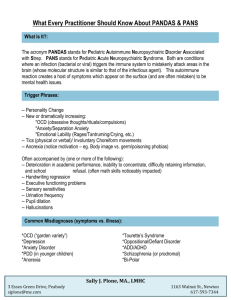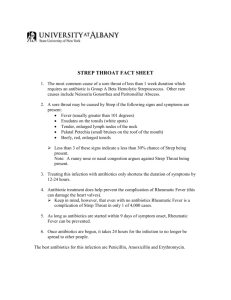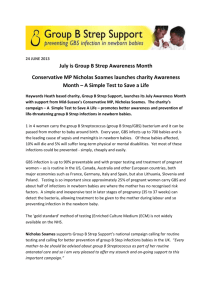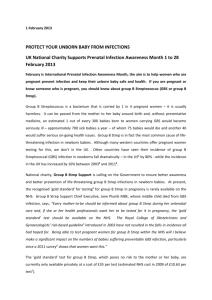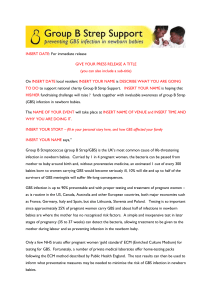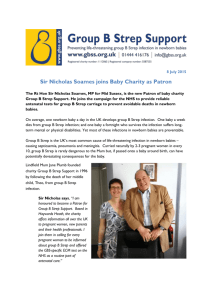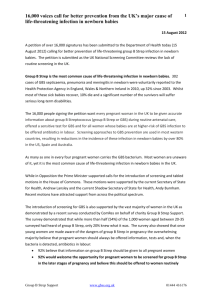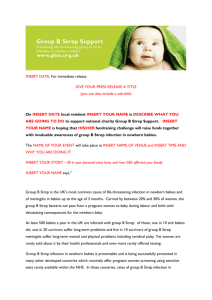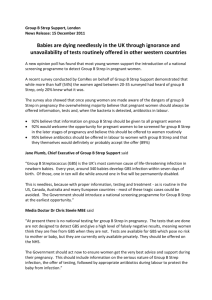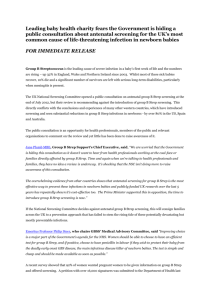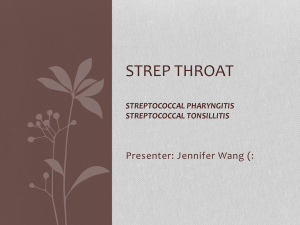Dutch guidelines fail to stop the rise of group B Strep infection in
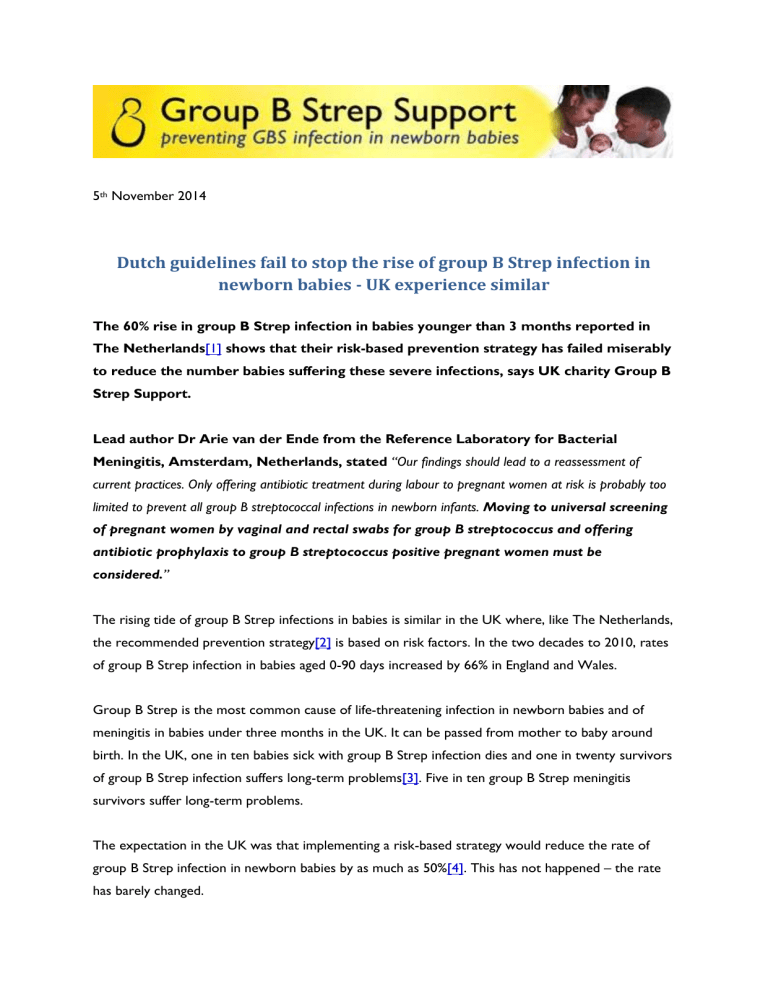
5 th November 2014
Dutch guidelines fail to stop the rise of group B Strep infection in newborn babies - UK experience similar
The 60% rise in group B Strep infection in babies younger than 3 months reported in
The Netherlands [1] shows that their risk-based prevention strategy has failed miserably to reduce the number babies suffering these severe infections, says UK charity Group B
Strep Support.
Lead author Dr Arie van der Ende from the Reference Laboratory for Bacterial
Meningitis, Amsterdam, Netherlands, stated “Our findings should lead to a reassessment of current practices. Only offering antibiotic treatment during labour to pregnant women at risk is probably too limited to prevent all group B streptococcal infections in newborn infants. Moving to universal screening of pregnant women by vaginal and rectal swabs for group B streptococcus and offering antibiotic prophylaxis to group B streptococcus positive pregnant women must be
considered.”
The rising tide of group B Strep infections in babies is similar in the UK where, like The Netherlands, the recommended prevention strategy [2] is based on risk factors. In the two decades to 2010, rates of group B Strep infection in babies aged 0-90 days increased by 66% in England and Wales.
Group B Strep is the most common cause of life-threatening infection in newborn babies and of meningitis in babies under three months in the UK. It can be passed from mother to baby around birth. In the UK, one in ten babies sick with group B Strep infection dies and one in twenty survivors of group B Strep infection suffers long-term problems [3] . Five in ten group B Strep meningitis survivors suffer long-term problems.
The expectation in the UK was that implementing a risk-based strategy would reduce the rate of group B Strep infection in newborn babies by as much as 50% [4] . This has not happened – the rate has barely changed.
Research published in 2002 [5] showed that antenatal screening strategies would prevent more cases of group B Strep infection in newborn babies than risk-based strategies. Countries which offer a universal screening strategy to pregnant women to identify group B Strep carriage, including the US, have seen falls in the rate of these infections in newborn babies of up to 86% [6] .
“The latest data from Netherlands is another ‘nail in the coffin’ for risk-based prevention strategies.” says
Chief executive of charity Group B Strep Support, Jane Plumb MBE. “It is encouraging to see The Netherlands call for change. Surely it is inconceivable that the UK will not do the same – after all,
what more evidence do we need to show that risk-based prevention is simply not working?”
For further information please contact:
Jane Plumb, Chief Executive, Group B Strep Support, for comment or greater detail
Tel: 01444 416176 e-mail: jplumb@gbss.org.uk
For further press information:
Sarah Fiedosiuk, media and awareness, Group B Strep Support on 01444 416176 email: sfiedosiuk@gbss.org.uk
Group B Strep Support, P O Box 203, Haywards Heath, RH16 1GF www.gbss.org.uk
. Registered
Charity No 1112065. Company Registration No 5587535
Editors Notes:
The Netherlands:
Using nationwide surveillance data from 1987 to 2011, a team of Dutch researchers examined group B Streptococcus disease trends before and after the introduction of these guidelines in The
Netherlands in 1999. The analysis revealed that the incidence of early-onset disease increased from
0.11 to 0.19 cases per 1000 live births between 1987 and 2011, and the incidence of late-onset disease increased from 0.03 to 0.13 live births.
This study was funded by the National Institute of Public Health and the Environment, the European
Union’s seventh framework programme, Netherlands Organization for Health Research and
Development, Academic Medical Center, and the European Research Council.
The Netherlands research was published in The Lancet Infectious Disease on 20 October
2014. Click here for the abstract.
The UK:
Early-onset group B Strep infection (in babies aged 0-6 days) increased on average by 1% per annum between 1991 and 2010, with rates increasing by 5% a year since 2005 [7] . Although there was a small reduction following the introduction of guidelines in 2003 (from 0.35 to 0.31 cases per 1,000 live births between 2003 and 2005), this returned to the same rate by 2006, and hit a high in 2010 of
0.41 cases per 1,000 live births.
National charity Group B Strep Support campaigns for much greater awareness of this potentially devastating infection among mums-to-be. Group B Strep Support wants to see every pregnant woman given accurate information about group B Strep as a routine part of her antenatal care, coupled with the offer of a sensitive test for group B Strep.
[1] Incidence of invasive group B streptococcal disease and pathogen genotype distribution in newborn babies in the Netherlands over 25 years: a nationwide surveillance study . Bekker V e al.
The Lancet Infectious Diseases, Vol 14, Is 11, 1083-1089, Nov 2014
[2] Emerging Trends in the Epidemiology of Invasive Group B Streptococcal Disease in England and
Wales,1991-2010 . Lamagni TL et al. Clin Infect Dis. (2013) 57 (5): 682-688
[3] Group B streptococcal disease in UK and Irish infants younger than 90 days . Heath PT, Balfour
G, Weisner AM, Efstratiou A, Lamagni TL, Tighe H, O’Connell LA, Cafferkey M, Verlander NQ,
Nicoll A, McCartney AC; PHLS Group B Streptococcus Working Group. Lancet, January 2004.
[4] Prevention of early onset neonatal GBS infection.
McCartney AC. Journal of Medical Screening, J
Med Screen 2001 8: 170.
[5] A population-based comparison of strategies to prevent early-onset group B streptococcal disease in neonates . Schrag SJ, Zell ER, Lynfield R et al; Active Bacterial Core Surveillance Team. N
Engl J Med. 2002 Jul 25;347(4):233-9.
[6] Revisiting the need for vaccine prevention of late-onset neonatal group B streptococcal disease: a multistate, population-based analysis Jordan HT, Farley MM, Craig A, Mohle-Boetani J, Harrison LH,
Petit S et al. . Pediatr Infect Dis J 2008; 27(12):1057–1064
[7] Emerging Trends in the Epidemiology of Invasive Group B Streptococcal Disease in England and
Wales,1991-2010 . Lamagni TL et al. Clin Infect Dis. (2013) 57 (5): 682-688
END
